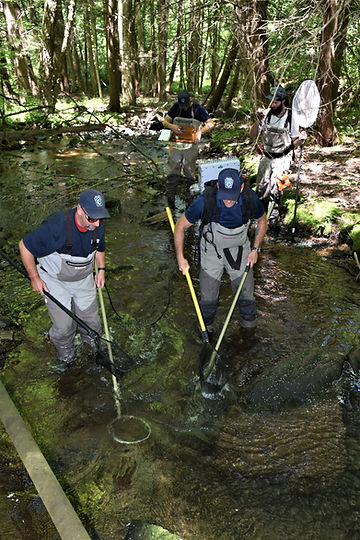Stream Surveys Shed Light on Coldwater Resources

Recently, I had the opportunity to join a team of biologists from the Pennsylvania Fish and Boat Commission (PFBC) as they surveyed the headwaters of East Branch Tunungwant Creek in McKean County. Although the main stem was designated Class A wild trout waters back in the early 1990s, the tributaries that converge to create the stream have never been sampled. Until now.
“We want to find out, if there are trout here, what’s the biomass in this stream,” said Brian Ensign, Fisheries Biologist for Area 2, “and does it qualify as a Class A wild trout fishery.”
According to Ensign, the biomass requirement for a Class A mixed brook/brown trout, as well as strictly brown trout, fishery is 40kg per hectare. However, in brook trout streams, the requirement is only 30kg per hectare.

For management purposes, every stream in the commonwealth is divided into sections, and each section is assigned a number, starting with the uppermost reaches which is labeled section 1. In order to get an accurate assessment of any section’s potential, at least 10% of it must be surveyed, and the survey must start as close to the mouth of that section as possible.
Each survey crew consists of at least four people. Two of them carry probes and nets and walk side by side up the stream. A third member keeps track of the distance they’ve gone and follows closely behind with another net used to pass fish back to the fourth member who then measures each one on a belly board and records the data. Before release, this fourth person also clips the trout’s caudal fin so that if they must resurvey a section at a later date, they know which fish have been previously captured.
They use gas and battery powered backpacks (this particular day, they opted for battery power) that can produce both AC and DC current. Tests are done to determine the conductivity of the water so that they know how to adjust the voltage flowing into the probes. Ideally, they want just enough to briefly stun the fish while they collect the necessary data.
As the crew progresses, they take frequent stream width measurements. Later on, back at the office, they use a Peterson estimate (which, in scientific jargon, is an equation designed to produce a statistically unbiased estimate for finite populations) to generate a spreadsheet that helps them determine if a stream will meet Class A criteria or if they need to return the next day to make a second pass.

Once a survey begins, the crew makes every effort to stay in the water until they’ve reached the finish line. In small streams, that often means climbing over, under, and through obstructions such as crossing logs, blow downs, or piled up debris. Staying in the water, probing every inch of it, is the only way to get the most accurate population samples.
Even still, despite their best efforts, some fish inevitably evade them. According to Ensign, smaller fish are least susceptible to electroshock because they lack the surface area of larger fish and therefore absorb less shock. Also, in bigger, deeper pools, it’s difficult to get close enough to stun or corner trout so that they can be collected.
In truth, Section 1 of East Branch Tunungwant Creek and its tributaries are not unique. They represent a tiny part of thousands of Pennsylvania streams that have never been assessed. In fact, of an estimated 67,725 streams in this state, more than 80% have never been surveyed. And until a stream is surveyed, we may never know how factors such as pipeline construction, road construction, and urbanization are impacting our coldwater resources.
The goal of the PFBC’s Unassessed Waters Initiative is to “proactively identify and properly classify the most at-risk streams which support naturally reproducing trout populations in order to protect, conserve, and enhance those waters as wild trout streams.” Unfortunately, there’s no easy way to do that except to survey each and every body of water.
Headwaters are especially important because they serve as nurseries for the rest of the watershed, and trout in a variety of sizes and age classes is indicative of a healthy fishery.
“We’ve been finding strong populations of young-of-the-year trout,” said Ensign, “not just on East Branch, but everywhere we’ve surveyed. This year’s hatch has been really good.”

Of course, it’s not all small trout that show up in these headwaters. I watched Ensign and his crew survey three different tributaries that day, some of them less than six feet wide, and every one of them produced quality wild brown trout up to 18 inches long. For an avid fisherman such as myself, it made me wonder how many good fish I’ve passed up over the years because I thought the water was too skinny.
“Another part of our job as we survey these streams,” added Ensign, “is to observe the quality of the habitat and make recommendations for improvements.” These improvements can help offset major issues such as erosion and sedimentation, forest fragmentation, and lost stream connectivity that could possibly threaten the resource.
Once the survey on the East Branch Tunungwant Creek tributaries was completed, we hiked back to our vehicles where more tests were performed to determine pH, alkalinity, buffering, hardness, and various characteristics of the water. All of these things combine to provide a deeper insight into the quality of the resource and what is needed to protect it. And then we hopped in our vehicles and headed off to the next stream where the same process would be repeated all over again.
One more stream survey down. Only 53,000 more to go.
Sign up for the Dark Skies Fly Fishing e-newsletter
It's free, delivered to your inbox approximately three times each month. Your information is always kept private and used for the sole purpose of keeping you up to date on blog posts and specials in the online store.
Sign Up Now